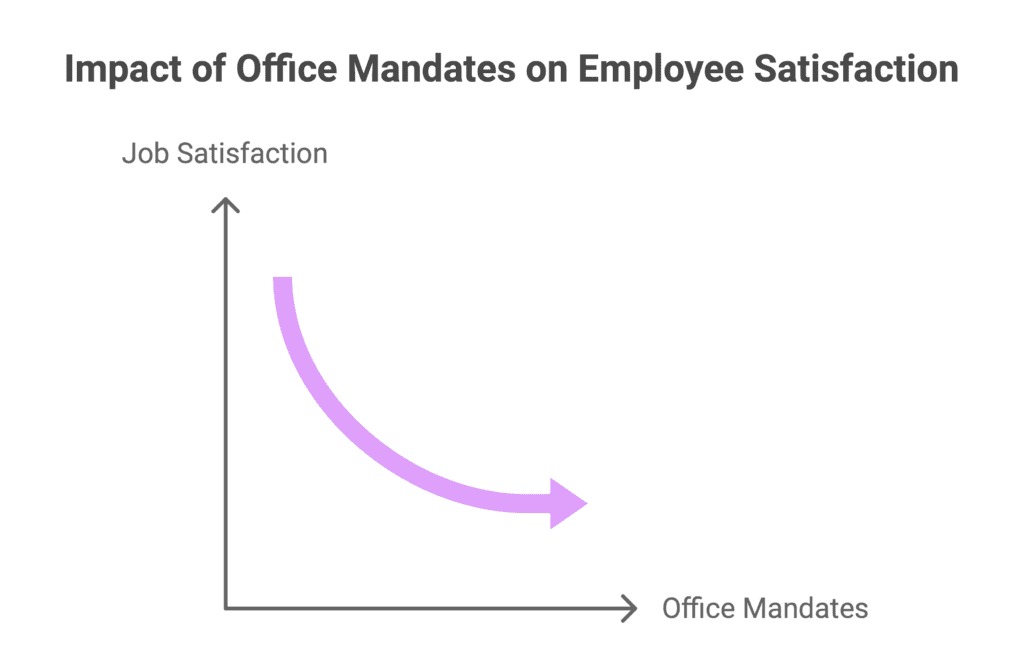A new Harvard study has found that 40% of people surveyed would willingly take a pay cut of 5% or more to continue working from more. Even more striking, 9% said they’d accept a 20% reduction in salary just to avoid returning to the office.
These figures aren’t just data points; they tell a powerful story about the changing dynamics of work. They reveal what many leaders have been slow to acknowledge: the office, as it stands today, isn’t offering enough value to outweigh the benefits of working from home. And because we know remote work doesn’t always allow for meaningful collaboration, it is on companies to make their offices more welcoming places to encourage employees back to the office.

The Problem with Return-to-Office Mandates
Many companies are still clinging to rigid return-to-office (RTO) mandates, hoping to restore pre-pandemic norms. But these mandates often backfire. Instead of fostering engagement, they create an “us vs. them” dynamic between leadership and employees. When workers feel forced back, it undermines trust and signals that their preferences and wellbeing are secondary to outdated managerial habits.
Mandates ignore a fundamental truth: people aren’t rejecting the office itself; they’re rejecting the way the office is being used.

What the Data Really Tells Us
The Harvard study reveals who values remote work the most. Interestingly, women are more likely than men to accept a 20% pay cut to maintain remote flexibility. This speaks volumes about how the office often fails to support diverse needs, particularly around work-life balance.
Turns out, 95% of employees want their office spaces to get a bit of a makeover. We’re talking better layouts, more private nooks, cooler amenities, and even some outdoor spots to break up the day. It just goes to show—people aren’t anti-office, they just want spaces that feel good to be in. If the office is going to compete with the comfort of home, it has to offer more than just desks and Wi-Fi. It needs to feel like a place where wellbeing, connection, and creativity thrive.
If employees are willing to sacrifice significant pay cut to avoid the office, it’s a clear signal that the traditional office environment isn’t meeting their needs.
The Office Isn't Dead, But It Needs a Purpose
Instead of enforcing RTO policies, companies should be asking: What can we do to make the office a place people actually want to be? If employees are willing to take a pay cut, alarm bells should be going off about forcing them back. The answer lies in reimagining the office as a hub for meaningful collaboration rather than a default location for daily tasks.
Here’s how companies can shift the narrative:
- Design for Collaboration, Not Presence: Offices should be optimized for activities that truly benefit from in-person interaction—brainstorming sessions, team-building events, and strategic planning. Rows of desks and rigid 9-to-5 schedules don’t inspire creativity or connection.
- Flexibility as a Core Value: Flexibility shouldn’t just be a perk; it should be baked into company culture. Trust employees to choose when and where they do their best work. The office should support flexibility, not replace it.
- Focus on Employee Experience: Invest in creating spaces that people enjoy. Comfortable environments, access to natural light, quiet zones, and areas designed for casual interactions can make the office feel less like an obligation and more like a resource.
- Data-Driven Decisions: Use workplace analytics to understand how and when people are using the office. This insight helps leaders make informed decisions about space utilization and employee preferences.
- Lead with Purpose, Not Power: Leadership should model flexible work behaviors themselves. When executives are seen using hybrid models effectively, it sets the tone for the rest of the organization.
Moving from Mandates to Meaning
Forcing people back into the office isn’t just a logistical issue; it’s a cultural one. Mandates may get people through the door, but they won’t foster engagement, loyalty, or productivity. To win hearts and minds, companies must focus on creating offices that offer value beyond what remote work can provide.
When the office becomes a place where employees feel inspired, connected, and supported, the question won’t be “Why do I have to come in?” but rather “When can I come in next?”
The future of work isn’t about choosing between the office and remote work. It’s about designing a work experience that gives people the freedom to choose what works best for them—and making sure the office is worth that choice.
Ready to create an office people actually want to come back to? Book a demo with Kadence’s hybrid work experts today and see how we can help you make the most out of your office space.





